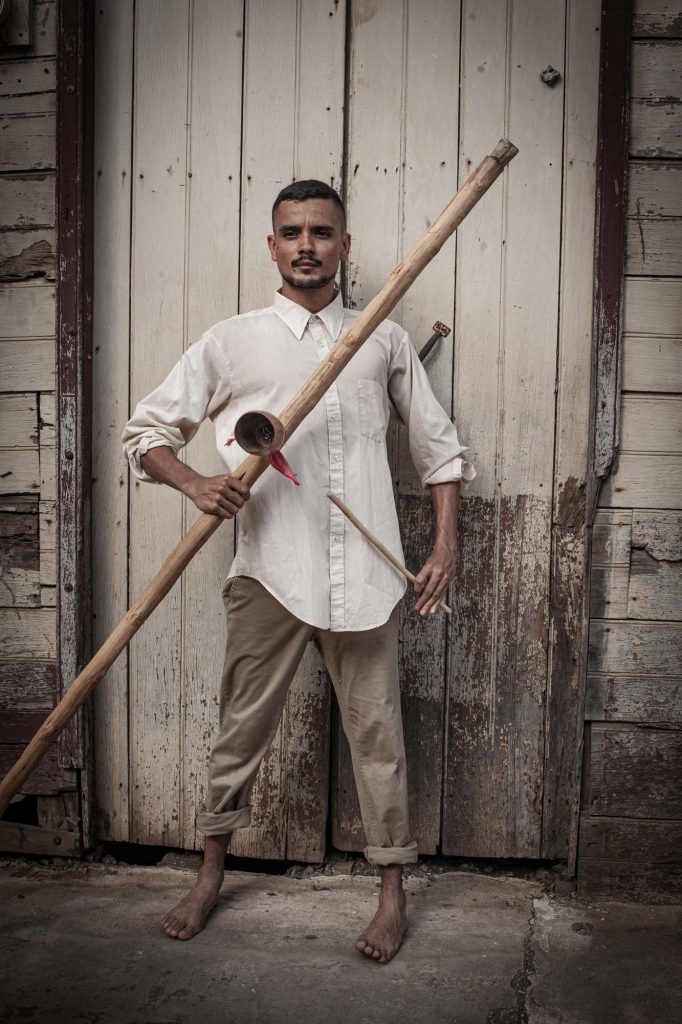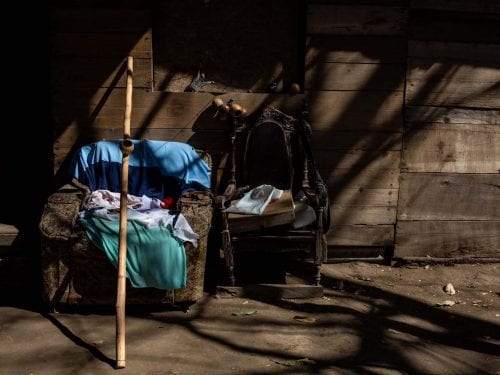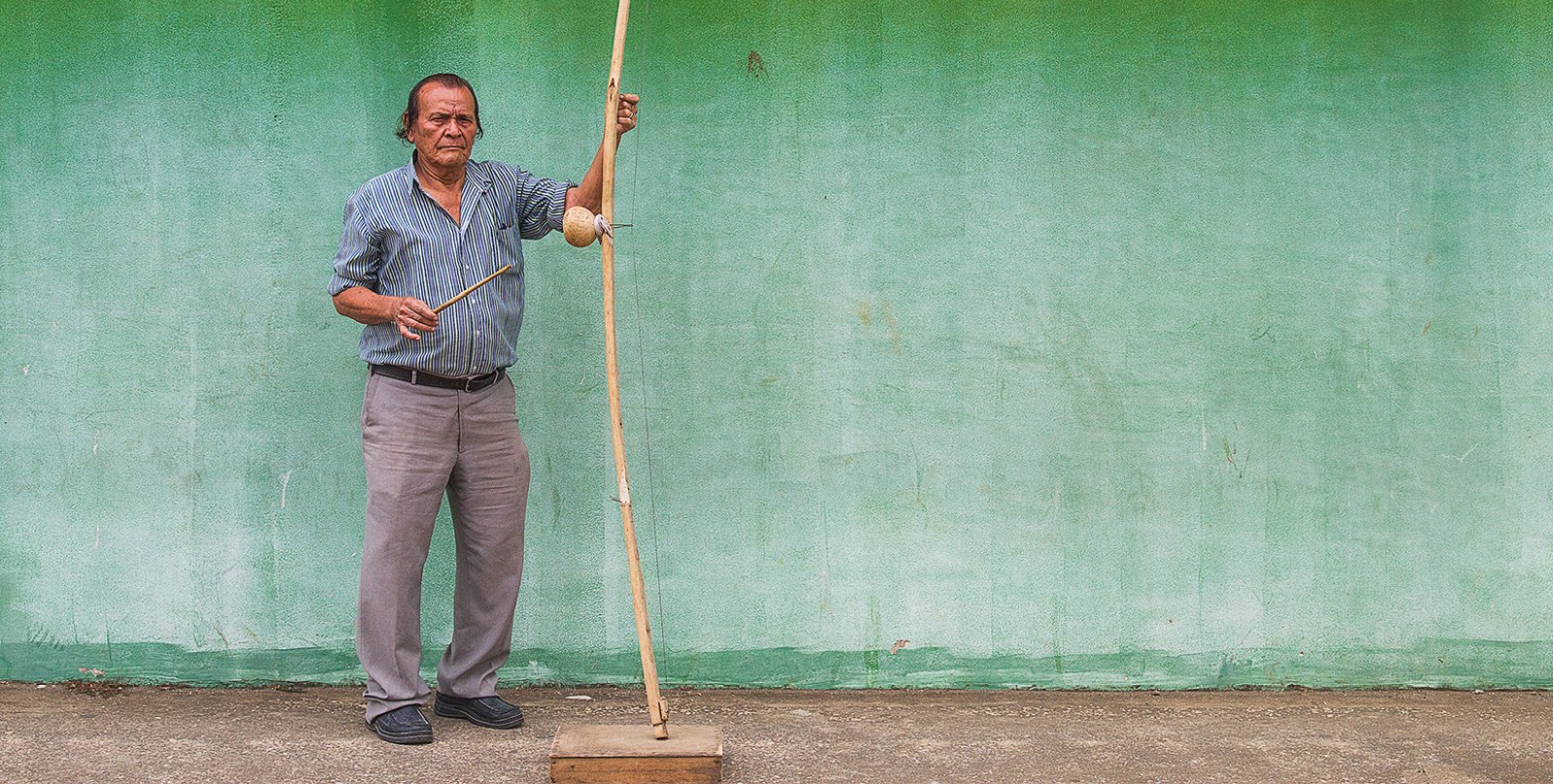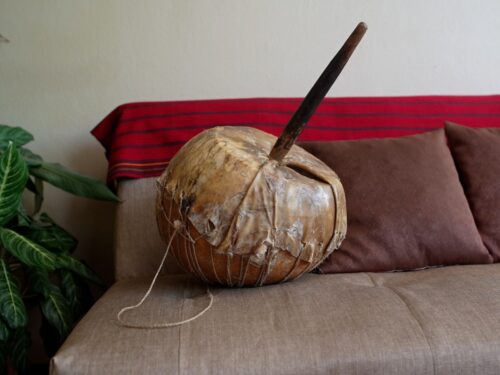
“Chorotegas. Spaniards. Africans. In the name of all who were before me, come and cleanse my blood.”
An actor calls this out while carrying a vessel of water on stage, surrounded by candles and accompanied only by a Guanacastean quijongo. The scene has the feel of a séance.
Minutes earlier, the people in the audience lit the candles on the floor one by one, and now they patiently await what this man dressed like a traditional sabanero (plainsman) has to say.
What they are seeing is Quijongo, Sonoridades y Movimiento (Quijongo, Resonance and Movement), a one-man play that combines modern dance and theater, performed by Julio Borbon, from Liberia, director of the artistic group Bor Bor Movement and Beyond.
“My idea was to create a living photograph of how these people lived in colonial times, because one of the peculiarities of the instrument is that it contributed a great deal to the socialization of the Sabaneros,” explained the performer, since they used the quijongo during parties at the haciendas.
Four years ago, he resumed an ancestral practice with a more contemporary format, but to get to this result, he first had to begin a journey that would allow him to better understand his own history and that of the province.
Ver esta publicación en Instagram
I Think, Then I Dance
“Before I created the [theatrical] work, I was having an identity crisis,” Julio recalled. During a trip through Mexico, he witnessed how that country celebrates its tradition and discovered that he was totally disconnected from his land.
“With art, I was beginning to feel a need to nourish my works with something. I wanted to sing; I wanted to act; I wanted my works to be a bit more robust,” he explained. But when he asked questions about his ancestors, he didn’t have enough answers.
That’s when he decided to sign up for a workshop on making and playing the quijongo (you can download a free pdf in Spanish here) from the Guanacaste Office of Culture. This very instrument became his pretext and his tool to talk about those other subjects that he and many people still don’t know much about: our African, Spanish and Chorotega heritage.
Every time he traveled to Santa Cruz to attend the workshop, he went with the quijongo in hand and people would stop him on the street to talk. “I felt like a superstar because people stopped me, wanting to talk and validate their knowledge with me because they see it and remember it. And I understood that people had a need to know more, and I said, ‘this has to be turned into a play.'”
Julio wanted to be a bearer of knowledge and a promoter of the instrument, but to do so, he had to investigate more about the mixture of these cultures.
That’s how, little by little, he deepened his knowledge of all the elements that come together in the work, such as his wardrobe, the beige shirt and pants with rolled up sleeves and pant legs, which hid the sabaneros’ grime from the haciendas, which we still see during the bull processions in Liberia. He also included Chorotega pottery, a poem in the Mangue language as a manifesto of the indigenous heritage and the quijongo as a reminder of the black slaves who arrived in the province in the 16th century.
“So, I took on the task of trying to gather as much academic information as possible and to translate all that was put in a book in a dynamic way,” he said.

“For me, as an artist, taking typical identity elements from our land has been fundamental to promoting cultural identity on stage”, Julio Borbón. Photo: Cristina DíazPhoto: Cristina Díaz
Lauran Bonilla Steiger, an art historian and professor at the National University’s Liberia campus, included Julio’s work in the content of her two classes, cultural tourism and arts and popular cultures.
“Often there’s the notion that research is something very academic and I wanted to show them the importance of research in all tasks, even in dance,” the historian pointed out.
Tourism with Culture
Julio sees his work as a great opportunity to hook tourists who visit the province through the performing arts, since they often look for this type of cultural experience beyond sun and beach tourism.
For this to happen, Bonilla thinks that it’s important that those who study tourism understand very well what elements make up their identity. She said that in her courses, the vast majority of Guanacaste students didn’t know what the quijongo was before seeing the play.
“People in tourism are sometimes the only spokespeople for our country and it’s important that they understand that people who come to Costa Rica like to learn a little more about who we are,” she pointed out.
Beyond the importance of seeing identity as a tourist attraction, the historian thinks it’s vital in order to have healthier societies.
“When we clearly understand our roots, our traditions, our heritage, we’re more rooted to what’s ours and with that, we have a greater sense of belonging,” explained Bonilla.
Just a month ago, the Commission for Safeguarding the Guanacastecan Quijongo, together with the State Distance University, organized the first National Quijongo Meeting as a way to celebrate this instrument and recognize the people who have kept this heritage alive.
Julio’s work was part of the meeting’s schedule of activities, which was loaded with concerts, recognitions and documentaries. In addition, it served as a platform to talk about the way to keep giving the quijongo many more years of life.
“I don’t think that to save the heritage, it has to be preserved as it is, because everything is advancing. Everything is alive and we need to approach the instrument from other places. I believe that it’s very necessary so that the instrument continues to reach other households, other explorations and other sounds,” said the artist.
How and where to see Quijongo, Sonoridades y Movimiento?
You can contact Julio Borbon through his Instagram account or by calling 7217-5942.







Comments